We practically bent double to get the scopes on the bird, more than a hundred feet overhead in the very top of the emergent ceiba tree.
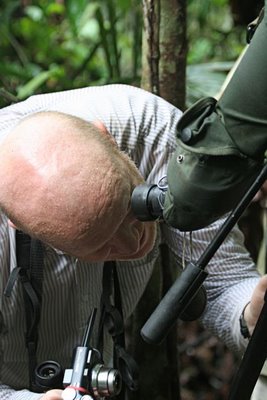 Mike Weedon gets an eyeful. Unnh!
Mike Weedon gets an eyeful. Unnh!For the next forty minutes, we admired this from our contorted positions:
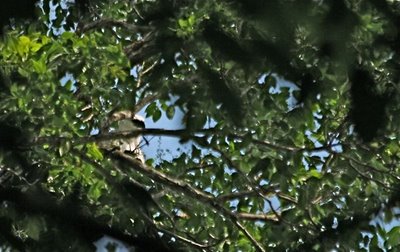
just the face of a young harpy. It was enough. It was wonderful. Every now and then the breeze would blow its feathers and raise its double crest and we'd sigh in admiration. We were looking at a harpy eagle, the most important bit of a harpy eagle, and a baby harpy at that.
Here's Ron Allicock, who found it for us in the first place. Obviously, the nest was a stakeout; it was a known nest, discovered when logging crews came to fell some trees in a selective cut. (The ceiba will not be cut, and the harpies are doing fine). But it takes some serious doing to see the eaglet even when you find the nest, because at the time we visited, it was trying its wings and "branching" all over the enormous tree, sometimes in view and mostly not, obscured by the canopy below the emergent tree. In fact, the second group of our tour who visited the nest the next morning missed seeing the eaglet. Let's have a moment of silence for those hopeful birders. No gloating here.
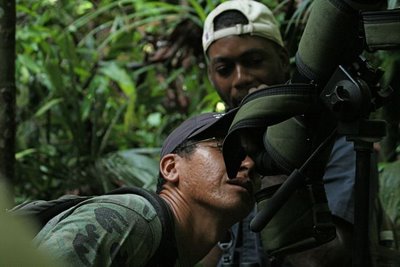
But Luke wanted more for us, so he and another expert guide set quietly off through the jungle to try to find a better vantage point.
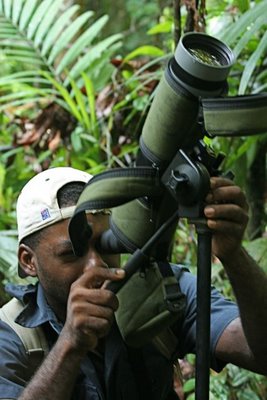
And find it they did.
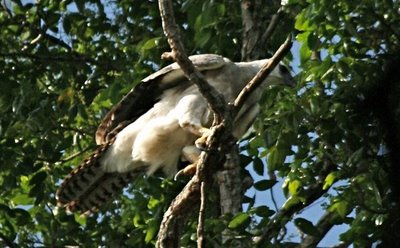
O.M.G. Now we had not just the head, but the whole enchilada, fluffy harpy eaglet bloomers, massive talons and all. Whooooooo.
The eaglet noticed.
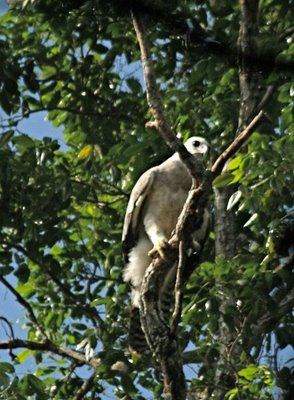
But it preened and seemed fairly unconcerned about these primates far below which were after all too large to practice upon.
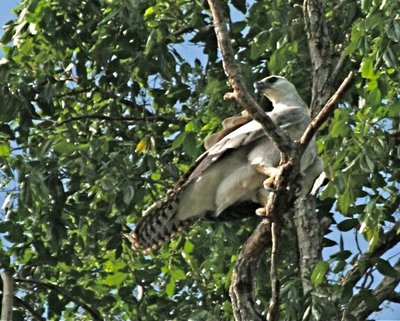
Harpy eaglets apparently come one to a nest. Though two eggs are laid, the second is abandoned as soon as the first hatches, and all the parents' focus goes to raising the sole princeling or princess. A harpy eaglet stays in the vicinity of the nest and in the care of its parents for a year or more, waiting for the occasional sloth/monkey to be airflighted in, and growing stronger until it's ready to try its six-foot wings and catch its own prey. With a reproductive rate like that, it's no wonder this apex predator is so rare.
Luke watches Erica get her camera lined up to digiscope the eaglet.
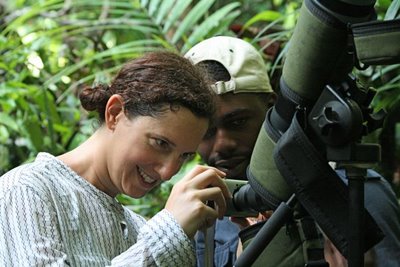
And the eaglet looks right back.
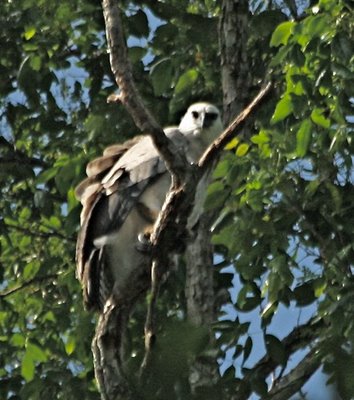 We quietly withdrew, grateful for this audience with a mythic bird.
We quietly withdrew, grateful for this audience with a mythic bird.Keep growing and thriving, prince or princess, whichever you be. Thank you, Surama Eco-Lodge, thank you Ron Allicock and Luke Johnson, US AID and the Guyana Sustainable Tourism Initiative, for taking us to the nest of the great forest harpy. I am grateful to be able to share the experience with so many people, and hopeful that one harpy eagle is ultimately worth more to the people of the area than many, many fallen logs.
Go see. Give Guyana, its giant otters, its potoos and giant anteaters and harpy eagles some of your travel budget if you can. It will not disappoint.
Back here on earth, I will be speaking and showing my paintings at the Riverside Artists' Cooperative Gallery, 188 Front Street, Marietta, Ohio 45750 at 6 pm on Friday, March 13. For more information please call (740) 376-0797. And don't forget to blurt "BLOG" when you introduce yourself!






19 comments:
O.M.G.! This was worth the wait... For a birder, it had to have been a religious experience!!
A religious experience indeed. A great moment in nature travel that may be near impossible to repeat. Wish I was there but reading your blog is definitely the next best thing. Thank you for showing us all this absolute wonderfulness!
Amazing bird and what a look - wow!
Six foot wing span? Thank goodness, you primates were NOT practice worthy.
I have really enjoyed reading about harpy eagles--a bird I had not previously heard of.
How fortunate to see this fabulous eagle and how thrilling to have that eagle look back!
Pretty awesomely wonderful.
I am both so happy for you and SOoooo jealous. Very nice photos, too. What an incredible bird! And I will keep trying . . .
All I can say is, "WOW". A moment truly defined. Thank you for sharing. It was almost as good as being there.
Wow, how very exciting that must have been! So glad you all got to see a young one in the wild. :c)
I thought the pictures of the captive harpy showed a magnificent bird but wow -- this is a magnificent bird in training! The abandonment of the second egg once the first hatches -- is that a common avian behaviour? Or is it related to the size of the bird, and the amount of resources required to get one bird to adulthood (as well as the likelihood of predation, which I'm guessing is pretty low here)?
Good questions, LOG.
Abandonment of the second egg is kind of a twist on the usual raptor modus operandi, which is to hatch two or three, then simply let the youngest starve or be killed by stronger nestmates (sometimes called Cain syndrome). It may be that harpy eggs are laid with longer intervals in between than most raptor eggs, so once the first chick hatches and the adults back off the 24-hr incubation, the second egg is too far behind to catch up.
Siblicide is no fun to watch, as anyone who's studied eagles or pelicans can attest.
Yes, it's all related to limited resources. The second egg or chick might be thought of as brood insurance, in case the first one doesn't hatch or is killed. The parents would be hard-pressed to catch enough monkeys and sloths to feed more than one enormous chick.
Congrats on your experience with the mythic bird! Glad he didn't think any of you were small enough for a bite!
To continue the thread about egg abandonment and siblicide, it is indeed no fun to watch, even on TV. I had to stop watching "The Life of Birds" segment in which the bird parents and siblings (I believe it was loons; I've kinda blocked it out) peck and abuse the smallest young and end up leaving them behind. It was too much to bear.
Sometimes science is just too harsh to learn about, even for a devoted science lover like me.
Oh. I am kind of sorry I asked.
I need a plastic cover for my keyboard to keep off the drool.
Hey Julie, we've been loving all your posts about Guyana, but these Harpy Eagle moments have been exceptionally inspiring.
Hope you had a good turnout at the gallery this evening. We're in Idaho at the moment, but sending positive energy from afar.
A life-time achievement award for getting the harpy- you are so lucky!
Did your hair stand up when it gave you that predatory look?
Wow, what a BEAUTIFUL bird!! Thanks for sharing, Julie. That would be an experience of a lifetime!
Hey, that bloke's head looks strange... Ah, I see, it's my head but from an angle I don't usually see! While you are all suffering from the glare of my dome, I will sneak in a shameless plug: if you want to see more pics and a teeny bit of video of that brilliant Harpy, stick the word Harpy in the search box at the top left of my blog at: http://weedworld.blogspot.com/
It took some serious persuading to get me to leave that glorious scene...
Mike
I've really enjoyed your blog, and feel privileged to be sharing your journey vicariously! You are a gifted story teller. Thank you!
Post a Comment